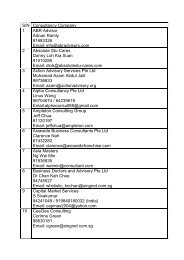A New Dynamic: Private Higher Education
A New Dynamic: Private Higher Education
A New Dynamic: Private Higher Education
- No tags were found...
Create successful ePaper yourself
Turn your PDF publications into a flip-book with our unique Google optimized e-Paper software.
Growth and typology1are identifiable. At the simplest level, all this growth means more access. 31 At a morecomplex level, we can dissect the access roles of different types of PHE, as in Box 1.3.Box 1.3.Access roles of PHE typeTYPE ACCESS ACCESS CONTRIBUTION MODES*DEGREEAll Varied Can bring additional revenue, which in turn allows thefinancing of more higher education slots, and can open upslots in the public sector. In addition, per student costs aregenerally lower in the private sector, allowing for more slotsfor the same money.Semi-elite** Limited Brings additional finance (fees, business, international); freesspace at good public institutions; diminishes brain drain.Religious/culturalModerateAccommodation of religious, ethnic or gender groups thatare judged underrepresented in public sector; brings financethrough voluntary contributions as well as tuition and freespublic sector space. Access through choice.Non-elite Large As soaring demand exceeds public (and other private)supply. Students from modest socio-economic background,often families' first generation in higher education, workingstudents, and job-seekers. Flexible delivery modes. Lowtuition, but access to fly-by-night institutions is dubious.For-profit***Publicprivatepartnerships***Limitedbutpotentiallylarge ****PotentiallylargeMostly overlaps non-elite type, but also semi-elite. Enlargedsize though tuition and external investment, domestic andinternational. Novel modes to increase access at efficientcost.Overlaps previous two categories. One route oftencombines an access college with a high-status university,bringing additional revenue and thus enrolment openings.Another route is allowing private (paying) students intopublic universities. (Other examples and models areoutlined in a subsequent chapter of this report.)* This column identifies contributions but does not evaluate them or claim they aresuperior to other modes, including types of expanded public access.** Elite PHE is very rare outside the United States. It can play some of the accessrole listed here for semi-elite.*** Cross-cutting forms rather than one of the chapter's three principal PHE types.**** Already large if one counts legal non-profits that are functionally for-profit.31 On the other hand, many prefer access mostly through grand expansion of the public sector. Or, shortof the traditional model of public expansion, proposals can contemplate charging tuition or bringingother forms of private finance into public institutions.23












